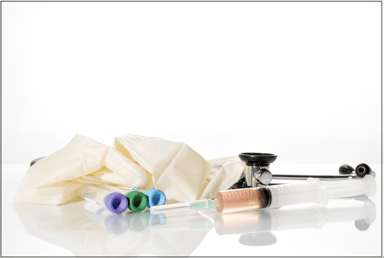A recent FDA ban on powdered medical gloves1 has brought attention back to airway inflammation and allergic reactions. It serves as a reminder to be vigilant about related latex allergy.

Latex allergy affects about 1 in 25 Americans, and reactions can range from mild to severe. In some extreme cases it can be life-threatening.2 Therefore it is important to learn the symptoms of latex allergy, and which groups are more at risk of developing it.
Natural rubber latex is made from the sap of the rubber tree, Hevea brasiliensis, which grows in Africa, Asia, and Central and South America. Allergic reactions to latex occur in people who develop sensitivity to the proteins found in natural rubber latex. There are some rubber products that are made with synthetic rubber, like latex house paints. These, however, are not made with natural latex and do not cause allergic reactions in people who use them.3
Natural latex or natural rubber products are found in many items that we use every day, such as: balloons, rubber bands, rubber household gloves, bandages, rubber balls, athletic shoes, tires, tools, waistbands and toys.
Symptoms
Latex allergic reactions occur when an individual’s immune system reacts to usually harmless proteins as if these were pathogens, like viruses or bacteria. Antibodies start working to fight off the invading proteins causing an inflammatory immune response. Most allergic reactions start as a rash on the area that came in contact with latex, but there may be other signs, including the following:
- Itching
- Hives
- Swollen lips or tongue
- Runny nose
- Shortness of breath
- Diarrhea
- Vomiting
- Dizziness
Anaphylaxis, a severe reaction to latex, can be life-threatening. Symptoms are stronger and more noticeable, like: bronchospasm, hypotension, syncope, wheezing, facial twitching and generalized edema. Latex proteins can travel through the air, and hypersensitive people who inhale these proteins may even go into a shock, accompanied with a severe breathing difficulty and a loss of consciousness.4 The American Academy of Allergy, Asthma, and Immunology (AAAAI.org) claims that people who suffer this condition are allergic to some foods that contain proteins with a similar structure as the one found in latex.5 In medical terms, this is called cross-reactivity. If you are allergic to latex, you should also avoid these foods:
- Stone fruits – including cherries, plums and nectarines
- Fruits in the berry, bacca and pepo family – bananas, tomatoes, strawberries, kiwi, grapes, avocado, and papaya
- Figs
- Melons
- Pineapple
- Celery
- Grains including wheat
- Seafood
- Tree nuts and legumes
Who is at risk?
There are certain high-risk groups where this condition is more common. For example, children with spina bifida, where an estimated 60% are allergic to latex.5 Children and people who have had lengthy surgeries or need frequent medical treatment are also at high risk. Latex allergies are often more common in people who have constant exposure to latex products, such as gloves. This is why healthcare workers, people who work in rubber manufacturing, childcare providers, food service workers and housekeepers are also at risk.
Studies seem to indicate that the severity of allergies due to latex come from repeated exposure to its protein. Prolonged exposure to latex can also end in occupational asthma, a chronic condition. The only way to prevent a latex allergic reaction is by avoiding the substance altogether. Fortunately, each day more and more products are being manufactured with synthetic rubber, or from another plant called guayule, a safer alternative for people who suffer from latex allergy. However, people who are at a serious risk of allergic reactions should carry auto-injectable epinephrine with them at all times.6
Latex is still a component of many medical supplies, like disposable gloves. The good news is that all of Sklar’s surgical instruments and supplies, including airway and intravenous tubing, syringes, catheters, dressings and bandages are latex-free.
Learn more about Sklar's surgical instruments by enrolling in our FREE CE IAHCSMM online course:
References
1 Mezher, Michael. (2016, December 16). FDA Bans Powdered Gloves.
2, 5 Kerr, Michael. (2015, May). Latex Allergies.
3 Latex Allergy. (2014).
4 Wayne, Gil. (2016, December 1). Latex Allergy Response: Nursing Diagnosis and Care Plans.
5 Latex Allergy. (2015, October).
6 Latex Allergy Treatment & Management. (2016).



